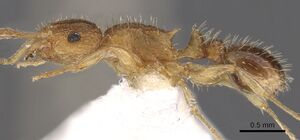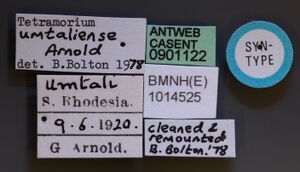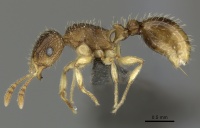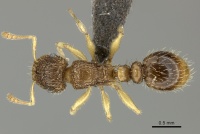Tetramorium umtaliense
| Tetramorium umtaliense | |
|---|---|

| |
| Scientific classification | |
| Kingdom: | Animalia |
| Phylum: | Arthropoda |
| Class: | Insecta |
| Order: | Hymenoptera |
| Family: | Formicidae |
| Subfamily: | Myrmicinae |
| Tribe: | Crematogastrini |
| Genus: | Tetramorium |
| Species: | T. umtaliense |
| Binomial name | |
| Tetramorium umtaliense Arnold, 1926 | |
A species of open habitats, e.g., grassland, bushveld and savanna, that has been collected in pitfall traps, by hand, and in a subterranean trap.
Identification
Bolton (1980) - In the squaminode-complex of this group T. umtaliense is immediately recognizable as it is the only species in which the entire cephalic dorsum is covered by a rugoreticulum, the predominant sculpture elsewhere in the complex being of longitudinal rugulae with a reticulum, if present at all, being confined to the occipital region. Besides this T. umtaliense is the only species in the group at present to have basigastral costulae on the first tergite. Although these are short and are confined to the area immediately posterior to the postpetiole-gaster articulation they are very distinctive.
Keys including this Species
Distribution
Latitudinal Distribution Pattern
Latitudinal Range: -18.96667° to -30.40972°.
| North Temperate |
North Subtropical |
Tropical | South Subtropical |
South Temperate |
- Source: AntMaps
Distribution based on Regional Taxon Lists
Afrotropical Region: South Africa, Zimbabwe (type locality).
Distribution based on AntMaps
Distribution based on AntWeb specimens
Check data from AntWeb
Countries Occupied
| Number of countries occupied by this species based on AntWiki Regional Taxon Lists. In general, fewer countries occupied indicates a narrower range, while more countries indicates a more widespread species. |

|
Estimated Abundance
| Relative abundance based on number of AntMaps records per species (this species within the purple bar). Fewer records (to the left) indicates a less abundant/encountered species while more records (to the right) indicates more abundant/encountered species. |

|
Biology
Castes
Worker
Images from AntWeb
   
| |
| Syntype of Tetramorium umtaliense. Worker. Specimen code casent0901122. Photographer Ryan Perry, uploaded by California Academy of Sciences. | Owned by NHMUK, London, UK. |
Nomenclature
The following information is derived from Barry Bolton's Online Catalogue of the Ants of the World.
- umtaliense. Tetramorium umtaliensis Arnold, 1926: 256, fig. 69 (w.) ZIMBABWE. See also: Bolton, 1980: 261.
Unless otherwise noted the text for the remainder of this section is reported from the publication that includes the original description.
Description
Worker
Bolton (1980) - TL 2.8-3.2, HL 0.68-0.74, HW 0.59-0.68, CI 86-92, SL 0.47-0.52, SI 76-81, PW 0.47-0.55, AL 0.80-0.90 (8 measured).
Mandibles densely longitudinally striate. Anterior clypeal margin entire, without a median notch or impression. Frontal carinae strong and sinuate, reaching back almost to the occipital corners. Antennal scrobes not strongly developed but quite conspicuous, broad and shallow. Eyes at midlength of sides of head, maximum diameter 0.16-0.17, about 0.24-0.25 x HW. Metanotal groove feeble or not impressed in profile. Propodeal spines of moderate length, broad basally but rapidly tapering to an acute apex, distinctly much longer than the low, triangular metapleural lobes. Petiole squamiform, much higher than long in profile and with the dorsum of the scale narrowly but bluntly rounded. In dorsal view the petiole and postpetiole both distinctly much broader than long, the postpetiole broader than the petiole. Entire dorsum of head from posterior clypeal margin to occipital margin with a coarse rugoreticulum. Dorsal alitrunk everywhere irregularly reticulate-rugulose. Petiole and postpetiole with traces of rugular sculpture, sometimes vestigial but the pedicel segments never entirely smooth. Base of first gastral tergite with a radiating series of short but distinct costulae. All dorsal surfaces of head and body with numerous elongate hairs, predominantly erect or suberect and mostly blunted apically. Scapes and tibiae with short appressed pubescence only. Colour yellow, the gaster somewhat darker.
Type Material
Bolton (1980) - Syntype workers, RHODESIA: Umtali, 9.vi.1920 (G. Arnold) (The Natural History Museum; Natural History Museum of Zimbabwe) [examined].
References
- Arnold, G. 1926. A monograph of the Formicidae of South Africa. Appendix. Annals of the South African Museum. 23:191-295.
- Bolton, B. 1980. The ant tribe Tetramoriini (Hymenoptera: Formicidae). The genus Tetramorium Mayr in the Ethiopian zoogeographical region. Bulletin of the British Museum (Natural History) Entomology. 40(3):193-384.
References based on Global Ant Biodiversity Informatics
- IZIKO South Africa Museum Collection

